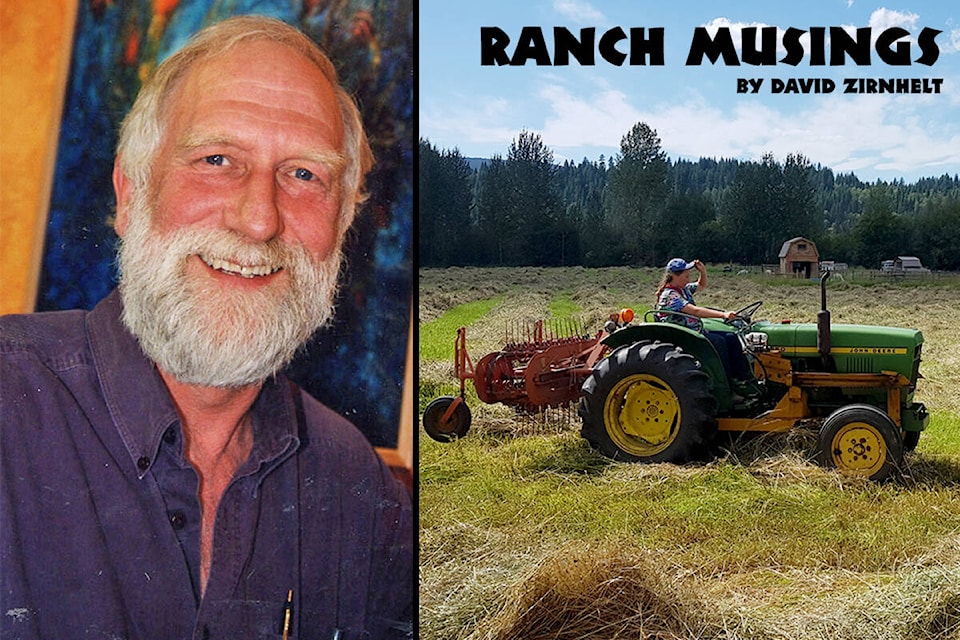My sense of ranching history and how we got to the present time is that the industry and its associated way of life has peaked in its present form.
The way forward for livestock and their stewards on the land is fraught with challenges, both in terms of maintaining social license to operate and increasingly to reduce greenhouse gas production.
Ranching is part of the ongoing agricultural revolution which has generally meant more healthy food for a burgeoning population. Yet this increase in food has come at a cost in terms of soil and ecosystem health (sustainability).
In B.C. as elsewhere we need to know our history in order to “fix” real contemporary problems in our management.
At present, the legislation governing the management of the grazing land in B.C. is not informed by goals around managing the forage (forbs and grasses mainly) on public lands. In other words, the utilization of feed plants by cattle and horses is not set in the Forest and Range Practices Act.
Recently, demonstration planning at the landscape level is seeking to address this shortcoming.
More resources have been put into that landscape planning. As I understand it, the First Nations of B.C. are to be involved, as are the range license holders (ranchers putting cattle on open range).
Presumably, a new higher degree of management will achieve more secure biological diversity, which increases resilience in ecosystems. That, in turn (we hope), will result in maintaining the production of the plants consumed by all species of animals, including grazing animals.
Back in 1982, Alastair McLean, the lead researcher in range management at the now-closed federal government Agriculture Research Centre at Tranquille near Kamloops, had this to say about ranching in the Canadian Encyclopedia:
“Ranching has changed over the century since its beginning from an extensive, casual, pioneering way of life to a modernized business enterprise. Management of the range and cost of production of beef has improved over the past 40 years. We can all hope that it will have as colourful and exciting future as it has a past.”
The present is 41 years since he wrote those words. That is 81 years of history now since the 1940s.
At the time of the establishment and reduction of the early Indian Reserves in the 1860s, ’70s, and ’80s, the colony of B.C. was flooded by settlers wanting to stake out land in the absence of treaties with the Indigenous inhabitants.
Opportunities existed for Indigenous people to manage horses and cattle on open range beyond the homesteading lands taken up by settlers.
Cattle were herded north and south in B.C. and east into what was to become Alberta, following the markets as they developed. Two bad winters in the 1870s caused many cattle to starve, as ranchers had thought the abundant grasslands of the Interior would support the cattle in the winter. Not so!
Again in 1896, the Kamloops area was hit hard by winter and it took a toll on the accumulating herds.
Victoria was, for a time, a major market for the cattle that were surplus to local needs in the Interior.
During the establishment of ranches, there were periods of overgrazing, and it became necessary for cattlemen to establish winter hay fields. In the 1920s it has been said of the Beecher’s prairie just west of Williams lake that “you couldn’t find a blade of grass.”
These periods of feast and famine on the grasslands supporting livestock virtually ended with the introduction and implementation of the B.C. Grazing Act of 1919.
One rancher from a fourth-generation ranch in the Chilcotin told me in the late 1980s that in his view, the range was in much better shape than it had been at the beginning of ranching.
In the 1990s proponents of a more ecological view began to transform grasslands around the middle of the Fraser River. Subsequently, the Churn Creek Protected Area and the Junction Wildlife area were created in order to raise the level of management and conservation of the grasslands.
newsroom@100milefreepress.net
Like us on Facebook and follow us on Twitter.
